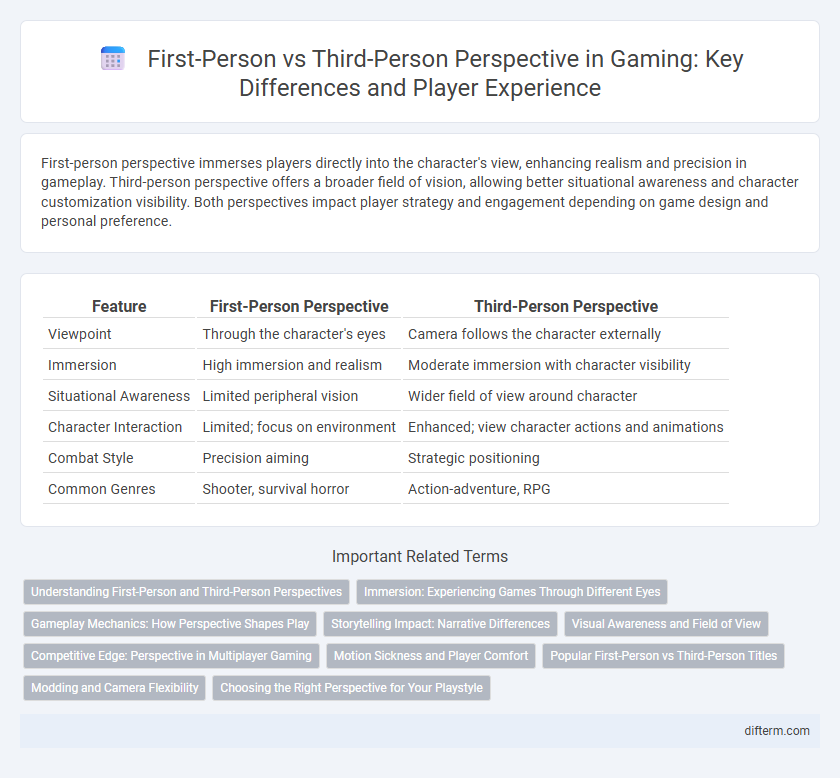First-person perspective immerses players directly into the character's view, enhancing realism and precision in gameplay. Third-person perspective offers a broader field of vision, allowing better situational awareness and character customization visibility. Both perspectives impact player strategy and engagement depending on game design and personal preference.
Table of Comparison
| Feature | First-Person Perspective | Third-Person Perspective |
|---|---|---|
| Viewpoint | Through the character's eyes | Camera follows the character externally |
| Immersion | High immersion and realism | Moderate immersion with character visibility |
| Situational Awareness | Limited peripheral vision | Wider field of view around character |
| Character Interaction | Limited; focus on environment | Enhanced; view character actions and animations |
| Combat Style | Precision aiming | Strategic positioning |
| Common Genres | Shooter, survival horror | Action-adventure, RPG |
Understanding First-Person and Third-Person Perspectives
First-person perspective immerses players directly through the character's eyes, enhancing realism and precision in aiming, commonly seen in shooters like Call of Duty. Third-person perspective offers a broader view of the character and environment, providing spatial awareness and strategic advantages in games like Fortnite and Assassin's Creed. Understanding these perspectives helps developers design gameplay mechanics that suit different player experiences and preferences.
Immersion: Experiencing Games Through Different Eyes
First-person perspective in gaming enhances immersion by placing players directly in the protagonist's shoes, delivering a more personal and intense experience through direct sightlines and interactive environments. Third-person perspective offers a broader spatial awareness and character visibility, allowing for strategic gameplay and emotional connection through visual character expression. Both perspectives shape immersion uniquely, catering to different player preferences and impacting narrative engagement and gameplay mechanics.
Gameplay Mechanics: How Perspective Shapes Play
First-person perspective immerses players directly into the character's viewpoint, enhancing precision in aiming and spatial awareness essential for shooter games. Third-person perspective offers a broader field of vision, allowing better situational awareness and strategic movement by displaying the avatar within the environment. Gameplay mechanics such as cover systems, navigation, and combat tactics vary significantly between perspectives, directly influencing player interaction and overall game design.
Storytelling Impact: Narrative Differences
First-person perspective immerses players directly into the protagonist's experiences, heightening emotional engagement and creating a deeply personal narrative connection. Third-person perspective offers a broader storytelling canvas by showcasing character expressions and environmental interactions, enhancing the depth and context of the narrative. This expanded viewpoint enables developers to convey complex story elements and character development more visually.
Visual Awareness and Field of View
First-person perspective in gaming offers immersive visual awareness by positioning players directly in the character's eyes, enhancing precision in aiming and interaction with the environment. Third-person view expands the field of view, allowing players to see their character and surroundings simultaneously, improving spatial orientation and strategic planning. Balancing visual awareness and field of view impacts gameplay style, with first-person favoring focused immersion and third-person supporting broader situational awareness.
Competitive Edge: Perspective in Multiplayer Gaming
First-person perspective in multiplayer gaming enhances spatial awareness and precision aiming, providing a competitive edge by immersing players directly into the action. Third-person perspective allows for greater situational awareness with a wider field of view, enabling better strategic positioning and threat detection. Understanding the strengths of each perspective helps players adapt their strategies to maximize performance and gain an advantage in competitive gameplay.
Motion Sickness and Player Comfort
First-person perspective in gaming can induce motion sickness due to limited peripheral vision and rapid camera movements, causing nausea and dizziness for sensitive players. Third-person perspective offers increased spatial awareness and less abrupt visual shifts, enhancing player comfort during extended sessions. Developers often provide adjustable field of view (FOV) settings and motion blur options to mitigate discomfort and accommodate diverse player needs.
Popular First-Person vs Third-Person Titles
Popular first-person games like Call of Duty and Halo emphasize immersive, direct player perspectives for intense combat experiences. Third-person titles such as The Witcher 3 and Assassin's Creed offer broader situational awareness and character-driven storytelling. Player preference often hinges on gameplay mechanics and narrative immersion provided by these distinctive viewpoints.
Modding and Camera Flexibility
Modding communities often favor third-person games due to the increased camera flexibility that allows for enhanced customization of character appearance and environment interaction. First-person perspectives restrict camera control, limiting modders' ability to showcase detailed character models and create immersive cinematic experiences. Third-person cameras enable dynamic angles and creative freedom, making them a preferred choice for extensive modding projects and user-generated content.
Choosing the Right Perspective for Your Playstyle
Selecting the right gaming perspective depends on your playstyle and situational awareness preferences. First-person views offer immersive experiences by placing players directly in the character's eyes, enhancing aiming precision and close-quarter combat. Third-person perspectives provide broader situational awareness, allowing for better strategic planning and character customization visibility.
first-person vs third-person Infographic

 difterm.com
difterm.com